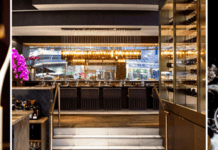As I write this, restaurants, hotels and attractions are transitioning to patios and making further business model “pivots” in anticipation of the long-hoped-for return of their customers. At George Brown College, the college is transitioning from the winter semester to the summer semester with an increase in students and staff back to the college for greater on-campus learning. There is no doubt these changes are eagerly anticipated and will help build the momentum for the further changes needed on our journey to recovery and industry health.
At the Centre for Hospitality & Culinary Arts (CHCA) the goal is to anticipate the needs of industry, prepare grads to be successful in the workplace, and also prepare industry partners for the new skills, talents and very real shifting expectations that placement students and grads now bring to the workplace. Recognition of these new expectations and the dynamics of a tight labour market are critical for educators and employers alike (Statistics Canada employment data showed the food and hotel industry has 210,000 fewer employees than it did in February 2020 — 17.6-per-cent fewer workers than in pre-pandemic times.
Here are a few observations from the educational perspective where we see “pain” points occur.
First, culinary and hospitality educators need to re-vamp delivery models to provide potential students with flexible schedules and choices in the structure of their study plans including:
- program delivery compressed into fewer days, “entry/exit/re-entry” options allowing students to smoothly move between semesters at school in leaner employment periods and semesters at work in the seasons of robust employment options; modular course options and choice for students between online/in person/hybrid delivery models that extend the reach beyond traditional target markets and provide students with the flexibility to manage education and life.
- collaboration and pathways among colleges and universities that ease mobility between institutions and start to leverage the urban, agricultural, resort, destination environments in which our educational institutions are located. Schools have been in a period of challenging enrolment over the past 10 years, however, the pandemic period has been particularly punishing. For example, the GTA’s first year enrolment in hospitality and culinary programs decreased from 5,230 in November 2019 to 3,539 in November 2020, a 32-per-cent decline (OCAS May/ June 2021). It may be hard for institutions to invest in partnerships and pathways that send students elsewhere, however it is this creativity that will generate fresh learning experiences with greater student appeal.
- investments and training to accelerate “SMART” online delivery – student-focused learning, leveraging multi-media, which is accessible to all, with relevant and current content and state-ofthe- art technology. That’s simple to say, but demanding to deliver. We’ve taken a big leap forward in online-delivery adoption to overcome COVID constraints; let’s not lose that drive for innovation and greater adoption as we seek the right mix of online and in person delivery models for–centered skills development.
Industry employers
Many have well-articulated the financial challenges of our sector, both the margin pressures employers face and the desperate need for a better financial model, equity, and a living wage for the sector’s workforce. I want to particularly highlight the issue of accommodation in our current labour crisis. If staff cannot afford to live within a reasonable commuting distance in the city in which your business is built, then your business will be starved for talent. Those destinations outside of population centres know the limited labour pool they face. I can confirm that there is significant competitive advantage that recruiting with an “accommodations-available” message represents – career changers, those new to the country, and young people emerging from school do not have the resources to buy or rent in housing markets such as we currently face, nor can they manage the lengthy and costly impacts of long commutes. Accommodation is one of the top barriers that graduates face in their selection between employment offers and your support in this area will pay off through the attraction and retention of the top talent in any labour pool.
Kudos to the many businesses that found creative flips and pivots to generate income during the most severe and restrictive of COVID times — the creativity shown in establishing shoulder-season outdoor patios, flipping to takeout, providing accommodation for new client groups, turning restaurants into marketplaces, delivering online events all illustrate the innovation and persistence for which this industry is famous. Now we need that ingenuity focused specifically on models that extend business operations to a more stable, year-round offering that includes weather and holiday appropriate flips. After more than two years of isolation and inactivity, consumers are ready to broaden their horizons in terms of culinary/hospitality experiences and we need to capitalize on this increased customer appetite.
We also have work to do with local governments and business and tourism councils in locations across the country that have seen much greater tourism volume as consumers explore “local” destinations, just as we had always wanted. Significant investment is needed to ensure customers are welcomed, their needs and hopes are served, and their dollars are spent, all the while confirming there is infrastructure in place, so the local community can cope with increased tourism volume.
Communication and marketing plans, as well as social media need to provide clarity on what successful enjoyment of a destination requires from behaviour to pre-booking of hotel rooms and leveraging of park-reservation systems. Communities that want the benefits of tourism dollars need to invest in the infrastructure to strengthen their offering, including oversight of short-term rentals, increased parking, and positive inclusive messaging.
After the tension and divisiveness of the past two years, we want to avoid unwelcoming “local -first” messaging, poor behaviour by visitors and increased conflict and disappointment. Our governments and agencies can make a significant difference with the immediate provision of tourism-planning resources, funds to launch new destinations to spread the tourism load, and investments in increased infrastructure from parks facilities, to parking and from marketing of new destinations to booking and crowd-control tools.
Finally, we all share the responsibility to focus on the great strengths of this industry and share the rewarding stories of making guests happy, serving a great product, delivering an inspiring experience and pursuing a fulfilling career. Negative media attention is driving away new entrants because they have been given the impression there are no good jobs, no respectful workplaces, or no viable long-term careers — what a mischaracterization of our sector. There are so many things we love about the culinary, hospitality and tourism world — we are lucky to be part of it so now is the time to focus on sharing that story.
Lorraine Trotter is the former Dean, Centre of Hospitality and Culinary Arts (CHCA) at George Brown College

















